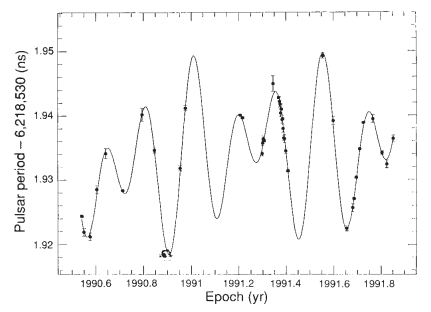Pulsar Timing
The very first exoplanet was found using this method. It was orbiting a pulsar called PSR B1257+12. But how does the method work? And what is a pulsar?
Though stars shine for thousands, millions, or billions of years, they do not last forever. What happens when a star eventually runs out of fuel depends on how the star's mass. Stars at least 10 times more massive than the Sun explode as supernovae. Some of these explosions leave behind a small but very dense star called a neutron star.

Credit: D. Frail, A. Wolszczan (Nature Journal)
Neutron stars spin very fast and have a very strong magnetic field. They also emit beams of radiation from their poles. As the neutron star spins, the beams sweep past the Earth at regular intervals. It's a bit like seeing the flashes of light from a lighthouse. We can detect these flashes, or pulses, of radio waves and call them pulsars.
The spin of a neutron star is very regular. This means that the timing between pulses is more accurate than an atomic clock. Any changes in the timing of a pulsar may be caused by a planet orbiting the neutron star!
This method is very good at finding low-mass planets. Even those that are much smaller than the Earth. Unfortunately, pulsars are not very common within the Milky Way. Plus, we are less likely to find an exoplanet orbiting a pulsar than a red giant star or main sequence star. The planet would have had to survive the supernovae explosion that produced the neutron star.
Planets near pulsars are probably not suitable for life. Neutron stars have magnetic fields that are trillions of times stronger than the Earth's.

